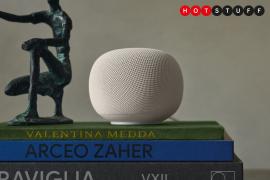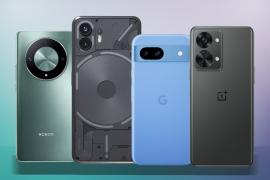Best mid-range TVs in 2025 for sharp pictures and serious value
We've rated and reviewed the best mid-range TVs, balancing picture quality, features and price in a way that makes sense for most people
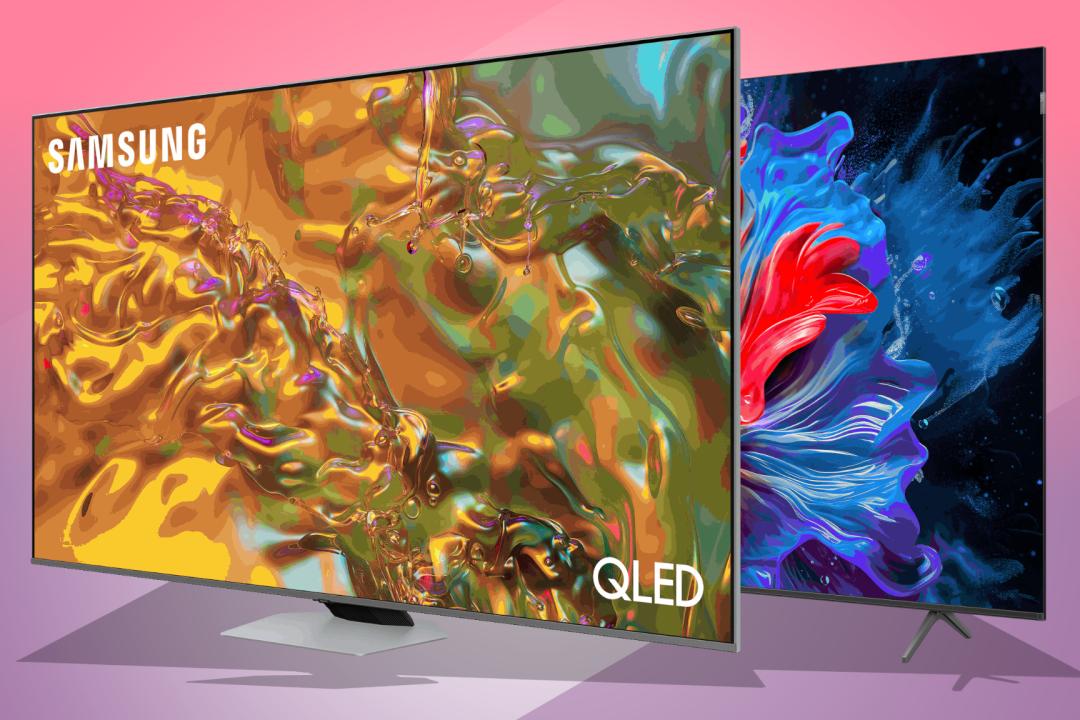
Not everyone wants – or needs – to splash out on a top-end OLED that costs more than a long weekend in Paris (such as those found in our best 4K TV guide). That’s where the best mid-range TVs come in. These are the sets that balance picture quality, features and price in a way that makes sense for most people. You’re still getting 4K resolution, slick smart features and support for the latest formats like HDR10+ and Dolby Vision – just without the eye-watering price tag.
And don’t assume “mid-range” means compromise. Some of the best TVs we’ve tested fall in this category, especially as features that used to be exclusive to flagship models have trickled down. Think: Mini LED panels, HDMI 2.1 ports, and gaming-friendly features like VRR and ALLM.
Whether you’re upgrading the main screen in your living room, looking for a second TV for the bedroom, or building a budget-friendly gaming setup, this guide will help you find the right model. We’ve focused on TVs that offer the best value, not just the lowest price – because there’s a difference.
Here’s what to look for, what to skip, and which mid-range TVs are actually worth your money.
Why you can trust Stuff: Our team of experts rigorously test each product and provide honest, unbiased reviews to help you make informed decisions. For more details, read how we test and rate products.
Quick list: What’s the best mid-range TV?
The LG OLED B4 (buy now) is one of the most affordable OLEDs on the market, this is a premium mid-range television for serious TV watchers.
The Samsung Q80D (buy now) is well equipped for gaming, while offering great mid-range performance. A good all-rounder.
The Amazon Fire TV Omni Mini-LED (buy now) is great value for money and great performance, mean an Alexa experience that fans will love.
The Philips PML9009 (buy now) will light up your room with Ambilight skills from this affordable Mini-LED model.
The Panasonic W95A (buy now) is a mid-range cinematic masterpiece that sees great picture performance from Panasonic.
The Hisense U7N (buy now) is defined by high brightness and as long as you keep it in check you’ll get great pictures.
The TCL P8K (buy now) is great value for money and loaded with specs, the TCL P8K is a great TV if you’re on a budget.
The Sky Glass 2 (buy now) comes with an integrated soundbar, which is a great feature, but Sky Glass 2’s appeal is really to those invested in Sky’s content.
The best mid-range TV you can buy today:
Best mid-range TV overall
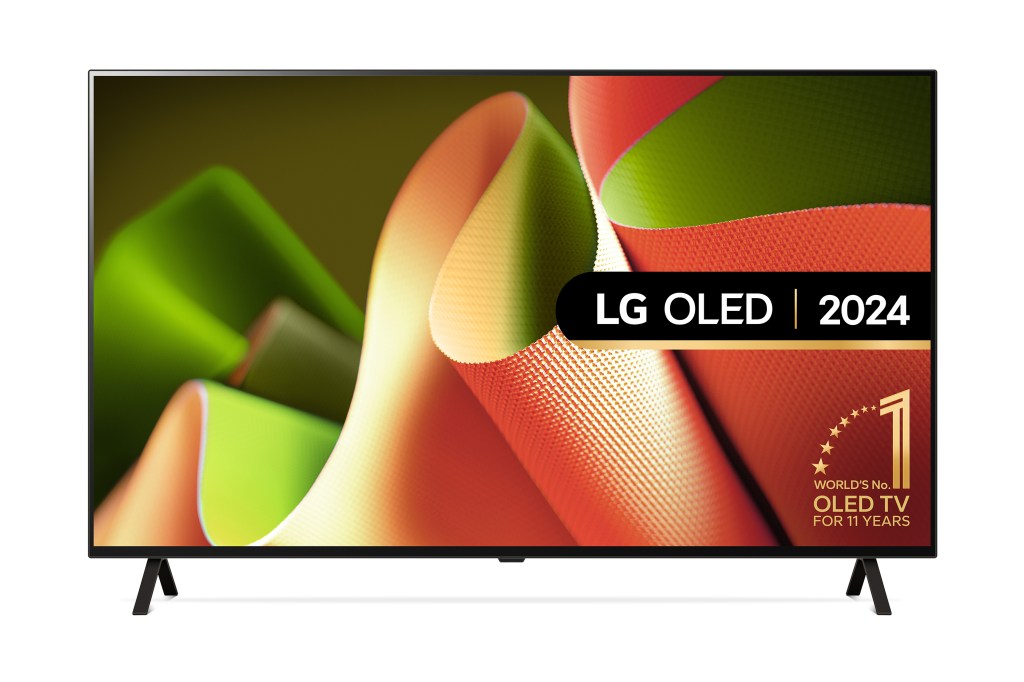
1. LG OLED B4
Stuff Verdict
One of the most affordable OLEDs on the market, this is a premium mid-range television for serious TV watchers.
Pros
- Outstanding picture quality with perfect blacks and rich, vibrant colours
- Premium, ultra-slim design and excellent value for money
Cons
- Lacks brightness compared to Mini-LED rivals
- Magic Remote’s gesture controls are awkward and frustrating to use
| LG OLED B4 specs | |
|---|---|
| Screen | 3,840 x 2,160 pixels, 48/55/65/75/83in, OLED, 120Hz, ALLM, VRR, HDR10/HLG/Dolby Vision |
| Sound | 20W 2.0ch with Dolby Atmos |
| Connections | 4x HDMI 2.1 incl. eARC, 2x USB-A, Ethernet, optical, Wi-Fi 5, Bluetooth |
| Operating system | webOS |
| Dimension | 1228 x 772 x 235mm, 14.5kg (55in with stand) 48.3 x 30.4 x 9.3in, 32.0lb |
For a long time, LG has been the name in OLED TVs. Not only does it sell its own range, but it supplies the screens to the likes of Philips and Panasonic too. LG’s entry-level OLED is the B model, which is where we meet the LG OLED B4.
This is a 2024 model (to be updated in the LG OLED B5 in 2025), but thanks to customary heavy discounting, you can snap up this 55-inch OLED for under $1000 / £900. It has the slimmest and most premium design of all the models on this list, but like many of the others, it has two feet at far ends of the screen.
The TV runs on LG’s famed webOS interface, which is nice and customisable, with all the streaming apps you’ll need, although I find it as dynamic as some other UIs. The Magic Remote in the box is the worst thing about this TV as the gesture controls are fiddly and quickly get frustrating.
There’s support for Alexa voice control, but it’s not as capable or as fast as it is on Amazon’s Omni Mini-LED, while LG’s ThinQ smart home network is also supported.
OLED has a natural advantage in that the light to each pixel can be completely switched off. That means that the black performance and contrast on the LG OLED B4 surpasses any other model on this list. It’s paired with vibrant colours that are rich and engaging – making it a movie lovers’ delight.
The display has some anti-glare properties, but the downside is that the brightness can’t match those Mini-LED TVs on this list. That means that highlights can be more impactful on rival models, while the LG OLED doesn’t fare so well in bright rooms because it can’t punch through reflections.
Hang this TV on the wall out of direct sunlight and you’ll be rewarded with sumptuous visuals, with Dolby Atmos support and accuracy and authenticity at its core.
It’s also worth saying that the LG OLED C4 is only a little more expensive so if you can stretch to that, you’ll get an OLED TV that’s a little brighter and a little more powerful too, while offering much the same experience.
If picture quality is your top priority, then start with the LG OLED B4.
Best mid-range TV for gaming

2. Samsung Q80D
Stuff Verdict
The Q80D is well equipped for gaming, while offering great mid-range performance. A good all-rounder.
Pros
- Strong gaming credentials with four HDMI 2.1 ports, 120Hz refresh rate and low input lag
- Flexible pedestal stand and solar-powered remote add convenience
Cons
- No Dolby Vision and fewer dimming zones than Mini-LED rivals
- Tizen interface can be sluggish and weak on content recommendations
| Samsung Q80D specs | |
|---|---|
| Screen | 3,840 x 2,160 pixels, 50/55/65/75/85in, QLED (Full Array LED with Quantum Dot), 120Hz, ALLM, VRR, HDR10/HDR10+/HLG |
| Sound | 40W 2.2ch with Dolby Atmos |
| Connections | 4x HDMI 2.1 (incl. eARC), 2x USB-A, Ethernet, optical, Wi-Fi 5, Bluetooth |
| Operating system | Tizen |
| Dimension | 1227.6 x 768.0 x 253.0mm, 19.8 (55in with stand) 48.3 x 30.4 x 9.3in, 32.0lb |
Samsung sells more TVs than anyone else and has a huge range to choose from. The Q80D is a 2024 model (which will be updated to the Q80F in 2025) and sits in the middle of Samsung’s range. That means it’s loaded with features without draining your bank account.
It’s also a mid-range TV with a pedestal stand. Why does this matter? Because the furniture you’re placing it on doesn’t have to be as wide as the TV which is a problem for competitor sets. It comes with two remotes, one that’s modern, slim and solar-powered and one that’s traditional and loaded with buttons.
The Samsung Q80D runs on Samsung’s own Tizen operating system. This gives access to all the apps for all the entertainment you could want – and the 7-year update guarantee means there’s plenty of support.
The interface can be a little slow at times and it’s not great for content recommendations, but there’s no shortage of features, from SmartThings integration to smart control for connected devices, as well as an ambient mode, if you want it.
Samsung uses Direct LED illumination with Quantum Dots for this TV, pushing vibrant colour and great brightness as we’ve come to expect from Samsung. That leads to engaging visuals, with HDR10+ – but there’s no Dolby Vision support.
There are fewer dimming zones here compared to the Mini-LED models on this list and that means that light can’t be handled quite as well – there are only 100 dimming zones here compared to over 500 on the Amazon Omni Mini-LED – and this TV looks expensive compared to its Mini-LED rivals.
But the contrast is still impressive and the picture quality is good, although some basic tinkering will reward you with a better overall picture. It’s not hugely bright, so while reflections are handled better than some, there isn’t really the power to cut through in bright rooms.
Samsung makes up for this with a great gaming experience, four HDMI 2.1 ports, low input lag and 120Hz support, so if you’re planning on gaming you’ll get a great experience here, boosted by the Game Bar for easy controls.
The sound performance is typical for this type of TV and doesn’t really bring anything too immersive, but there’s enough bass to make it sound substantial enough.
Best mid-range TV for Amazon customers
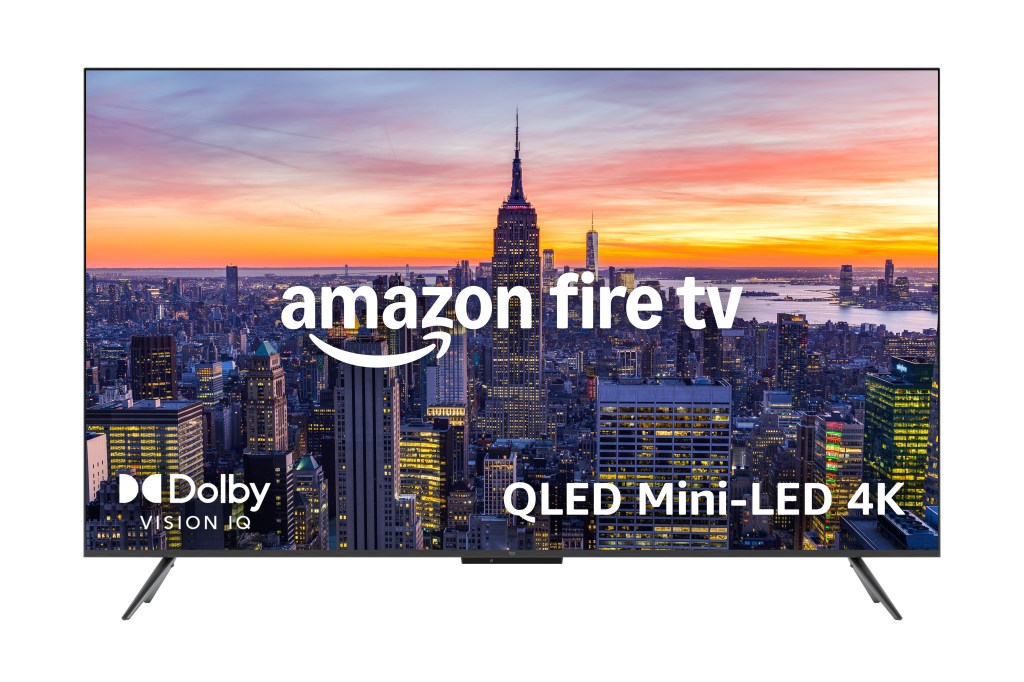
3. Amazon Fire TV Omni Mini-LED
Stuff Verdict
Great value for money and great performance, mean an Alexa experience that fans will love.
Pros
- Excellent value with high-end specs like 512 dimming zones, 144Hz support, and Dolby Vision
- Hands-free Alexa and Freely support make it a smart, convenient option for connected homes
Cons
- Fire TV OS includes adverts, which can be intrusive
- Sound performance is underwhelming and may benefit from a soundbar
| Amazon Fire TV Omni Mini-LED specs | |
|---|---|
| Screen | 3,840 x 2,160 pixels, 55/65/75in, QLED (Mini-LED with Quantum Dot), 144Hz, ALLM, VRR, HDR10/HDR10+ Adaptive/HLG/Dolby Vision IQ |
| Sound | 24W 2.1ch with Dolby Atmos |
| Connections | 4x HDMI (2x HDMI 2.1 incl. eARC, 2x HDMI 2.0), 1x USB-A, Ethernet, optical, Wi-Fi 6e, Bluetooth |
| Operating system | Fire TV OS |
| Dimension | 1230 x 800 x 300mm, 21.3kg (55in with stand) 48.4 x 31.5 x 11.8in, 47.0lb |
Amazon’s own range of TVs is topped by the Fire TV Omni Mini-LED. It offers great specifications for the price, boosted by Amazon’s regular sales, which means it’s often discounted.
Fire TV OS can be found on many TVs and many sets offer Alexa, but the Omni Mini-LED offers hands-free Alexa, so you can talk directly to it. This makes it easier to find content, open channels, or make adjustments without needing the remote.
The downside of Fire TV OS is that it has some adverts in it, but generally I like the recommendations it offers and I find it a quick interface to navigate.
The design is good for these prices, with a slim metal bezel framing the screen, but pay attention to the stand, as the two feet sit towards the ends of the TV, so you need to make sure your TV stand is wide enough to accommodate it.
The Fire TV Omni Mini-LED stands out because to really delivers on the specs. This is a 4K HDR TV – supporting HDR10+ and Dolby Vision – but also giving gamers a little more with support up to 144Hz, for super-smooth visuals.
Amazon has packed this TV with 512 dimming zones (the 65-inch model gets 768), which means greater accuracy when controlling those Mini-LEDs. Good vibrant colours come through and there’s impressive HDR results thanks to the 1400 nits peak brightness. This also helps cut through reflections, to keep this TV visible in brighter rooms.
Fire TV OS is loaded with streaming apps, but one of the highlights is Freely support. This means you don’t need to connect it to an aerial, you can stream your Freeview broadcast channels instead – just as you can on Sky Glass 2.
The picture can’t deliver the same black performance as you’ll get from the LG OLED B4, but it’s much brighter, bringing punch to colours. Those dimming zones keep bleed (when bright highlights spread into dark areas) to a minimum, for a picture that’s generally very good.
The sound is a little weak, but I love that you can just use this as an Alexa device, not only for TV, but playing music, viewing your connected cameras and asking all those questions that Alexa is good at answering.
Best mid-range TV for immersion
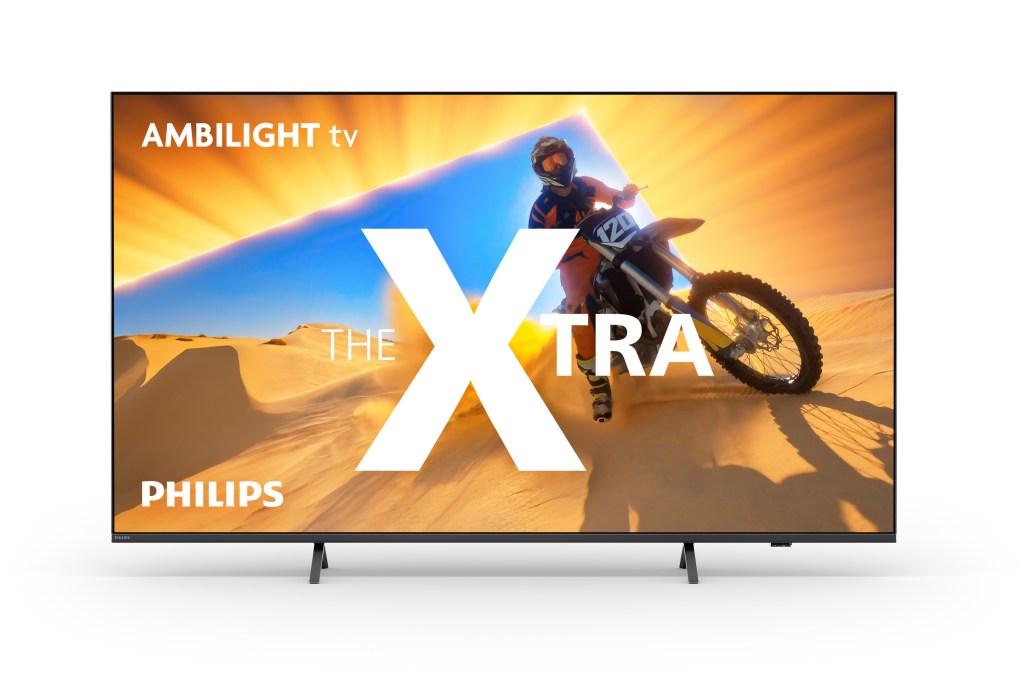
4. Philips PML9009
Stuff Verdict
Light up your room with Ambilight skills from this affordable Mini-LED model.
Pros
- Unique Ambilight feature adds immersion and visual flair that no other brand offers
- Strong gaming support with 144Hz refresh rate and full HDMI 2.1 connectivity
Cons
- Titan OS is basic compared to rivals and the remote is dated and infrared-only
- Reflective screen and average brightness make it less ideal for bright rooms
| Philips PML9009 specs | |
|---|---|
| Screen | 3,840 x 2,160 pixels, 55/65/75/85in, QLED (Mini-LED with Quantum Dot), 144Hz, ALLM, VRR, HDR10/HDR10+/HLG/Dolby Vision |
| Sound | 40W 2.0 with Dolby Atmos |
| Connections | 4x HDMI 2.1 (incl. eARC), 2x USB-A, Ethernet, optical, Wi-Fi 5, Bluetooth |
| Operating system | Titan OS |
| Dimension | 1231 x 780 x 270mm, 15.5kg 48.5 x 30.7 x 10.6in, 34.2lb |
Philips offers a very good reason to buy its TVs and it’s called Ambilight. Ambilight fires coloured light out of the back of the screen, able to match the content with light spread across your walls. It can expand what’s on the screen and make things more immersive, which is what I love about it, but it can also be a distraction. Essentially, if you don’t like it, don’t buy this TV.
Philips has a wide range of TVs with the PML9009 nicknamed “The Xtra”. It’s the TV that’s a step-up from “The One”, giving a little more performance for a better experience than the entry-level model and sitting below the company’s OLED models. This is a 2024 TV and will be updated with the Philips MLED 910 in 2025.
This TV runs Philips’ own Titan OS and the remote is loaded with buttons and needs line of sight to work, so it’s not quite as good as some of the others on this list, but I found it gave me access to all the major streaming services and navigation is very like Android.
Titan OS doesn’t offer as many features as you’ll find from the likes of Tizen OS on Samsung TVs or Fire TV OS from Amason, but it’s fast enough to navigate.
This is a Mini-LED TV with Quantum Dots, so it delivers on both the brightness and the colour that rival Mini-LED sets offer. The brightness isn’t quite as high as some of its rivals and although the number of dimming zones isn’t specified, it doesn’t have quite the same skill as you’ll find on models like the Hisense U7N or Amazon Fire TV Omni Mini-LED.
There’s a full set of support for HDR formats, including Dolby Vision and HDR10+, and while those formats look great when streaming, this is a fairly reflective panel, so it doesn’t stand up too well in a brighter room. But you do get a 144Hz panel here to support gamers with a full set of HDMI 2.1 connections.
The sound system offers Dolby Atmos and DTS:X support, but the speakers don’t really have the gusto to deliver any sort of immersion, so you’ll be better with a soundbar.
But Ambilight is a unique feature, which makes this mid-range set stand out. It’s also towards the affordable end of the Mini-LED price bracket and while it doesn’t have the visual skills that other models offer, it’s quite a statement TV once you get it into your home.
Best mid-range TV for movies
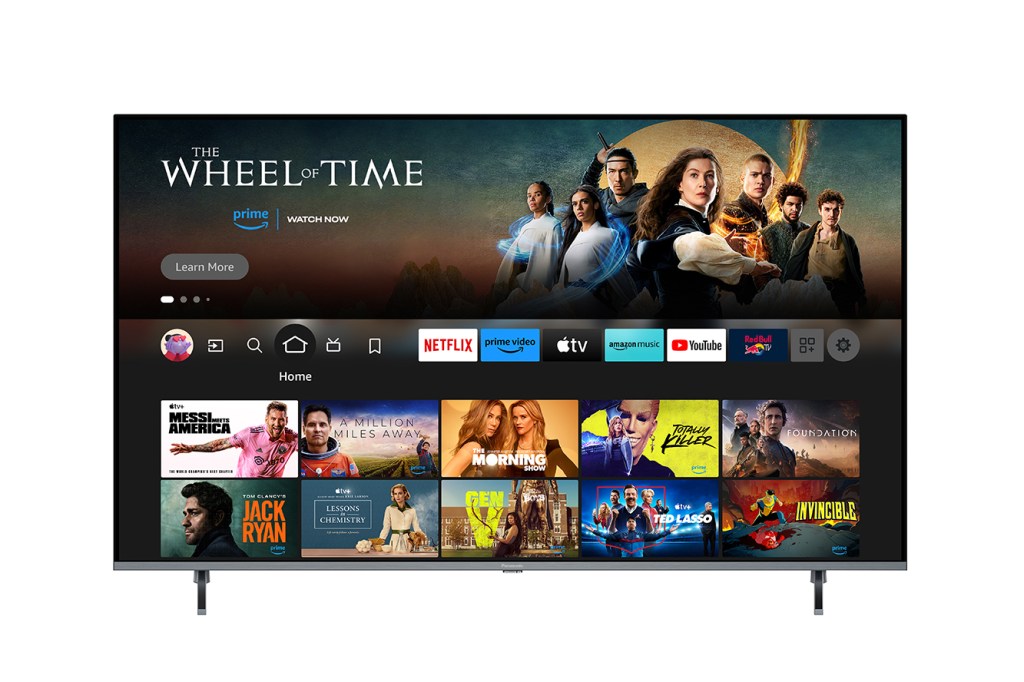
5. Panasonic W95A
Stuff Verdict
Mid-range cinematic mastery sees great picture performance from Panasonic.
Pros
- Accurate picture, ideal for movie lovers who prefer natural colours
- Good range of picture control settings for those who like to tweak
Cons
- Not as bright or vibrant as some rivals, especially in HDR content
- Sound isn’t as robust as other models, requiring a soundbar for better audio
| Panasonic W95A specs | |
|---|---|
| Screen | 3,840 x 2,160 pixels, 55/65/75/85in, Mini-LED, 144Hz, ALLM, VRR, HDR10, HDR10+ Adaptive, Dolby Vision IQ, HLG |
| Sound | 50W 2.1ch with Dolby Atmos |
| Connections | 4x HDMI (2x HDMI 2.1 incl. eARC, 2x HDMI 2.0), 3x USB-A, Ethernet, optical, Wi-Fi 5, Bluetooth |
| Operating system | Fire TV OS |
| Dimension | 1228 x 775 x 269mm, 18kg 48.3 x 30.5 x 10.6in, 39.7lb |
The W95A is Panasonic’s top Mini-LED for 2024 (to be updated with the W95B later in 2025) and wants to be the centrepiece of your home cinema. That it’s on this list is thanks to a considerable adjustment in the price that brings it into alignment with the likes of the Hisense U7N.
Solid metal feet sit towards the ends for this set, so if you’re not wall-mounting it, you’ll need a wide stand. There’s heft to the remote as well as the TV itself and it’s perhaps a little old fashioned compared to the remote you get with the Samsung Q80D – but it feels like good quality.
However, that remote offers quick access to streaming services and as this set uses Amazon’s Fire TV OS, there are plenty of apps to access – as well as integration with Alexa. There’s no handsfree Alexa like on the Amazon Omni Mini-LED, but it supports a wider range of functions than you’ll find from other models.
Although this TV uses Fire TV OS, you’ll find a lot more settings for things like picture controls than you get on the Fire TV Omni Mini-LED, so if you’re a tweaker looking for picture performance, this could be the TV for you.
This Panasonic TV uses a Mini-LED panel, supporting all the HDR formats and offering up to 144Hz for gamers.
Out of the box the Panasonic W95A doesn’t look as bright and vibrant as the Hisense U7N or the Amazon Fire TV Omni Mini-LED, but that’s perhaps more of a reflection of Panasonic’s philosophy than anything else. Fire up a big screen movie and you won’t be distracted by colours that are too vibrant, because it looks natural instead.
That’s likely to appeal to those looking for accuracy and if you can’t stretch to the LG OLED B4 – or want something a little brighter – then Panasonic’s movie mastery is likely to appeal. It can struggle a little with reflections, but it does have the brightness to cut through to deliver a great performance.
Despite being fitted with a 50W sound system, I didn’t find it as robust as some other models, so definitely worth adding a soundbar to bring the sound up the level of the picture performance. That only leaves you with one HDMI 2.1, so if you’re planning on connecting gaming devices, your options are then limited to one remaining HDMI port.
Best TV for brightness
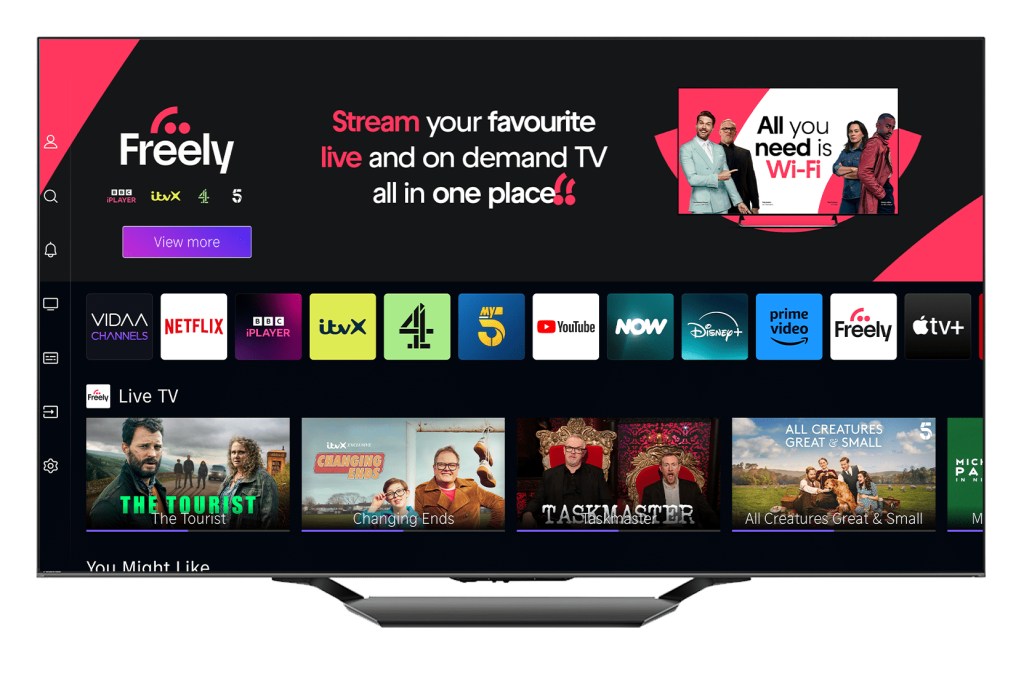
6. Hisense U7N
Stuff Verdict
High brightness defines the Hisense U7N and as long as you keep it in check you’ll get great pictures.
Pros
- Very bright screen makes it ideal for bright rooms and cutting through reflections
- Central stand design fits on smaller furniture, unlike TVs with wide-set feet
Cons
- Build quality feels cheaper, with some flex in the frame and a bulky remote
- Needs tweaking out of the box for best performance; colours can look unnatural
| Hisense U7N specs | |
|---|---|
| Screen | 3,840 x 2,160 pixels, 55/65/75/85in, QLED (Mini-LED with Quantum Dot), 144Hz, ALLM, VRR, HDR10, HDR10+ Adaptive, Dolby Vision IQ, HLG |
| Sound | 40W 2.1 with Dolby Atmos |
| Connections | 4x HDMI 2.1 incl. eARC, 2x USB-A, Ethernet, optical, Wi-Fi 5, Bluetooth |
| Operating system | VIDAA Smart OS |
| Dimension | 1231 x 781 x 295mm, 15.4kg 48.5 x 30.7 x 11.6in, 34.0lb |
High brightness and solid specs meet great value for money – if you don’t want to spend big on a big brand then the likes of Hisense and TCL are the brands to go for. The Hisense U7N has a solid reputation in the mid-range category for its performance.
But before I get there, I just want to mention the stand: like the Samsung Q80D, it has a central stand so it’s ideal for placing on a smaller piece of furniture, while most other models need a wider surface to sit on, so that’s a good starting point.
The TV isn’t built to the same quality as some of the better-known brands – I found a little more flex around the screen when I was dusting it than I expected – but otherwise it doesn’t look too different to other models on this list.
The remote is a little hefty and the controls are a little fiddly, as hitting the pause button pops up an on-screen controller, which you then have to press again to make it do something.
However, Hisense’s own VIDAA OS is swift and fast to use, supporting all the major streaming apps, but there’s no Spotify app. I also really like that the user interface is bright – too often the brightness drops on the UI, so things look a little dull – but not so here.
The Hisense U7N is packed with a bright panel that out of the box delivers more punch than many rivals. That makes sense, as Hisense has been pushing the message that brighter is better, although in some cases I found that brighter isn’t better and needs reeling back in a little.
Dolby Vision IQ – which adapts to the brightness of the room – was much better when switched to “custom” and some tweaks made to reduce the brightness being pushed, as daylight viewing got a little out of control
Expect to do a little tweaking to get the best out of this TV. But brightness is the defining feature of this set and in a bright room it will happily punch through reflections, despite the screen being a little glossy.
There’s plenty of colour vibrancy too, but with only 240 dimming zones on the 55-inch model, the performance isn’t as good as the Amazon Omni Mini-LED when it comes to light control and delivering darker scenes. I also didn’t find the colour to be as natural as the Panasonic W95A.
The sound system supports Dolby Atmos and DTS:X, but doesn’t really deliver immersive audio. It sounds better than the Panasonic W95A and the Amazon Mini-LED model, but it can’t get close to Sky Glass.
Best budget mid-range TV
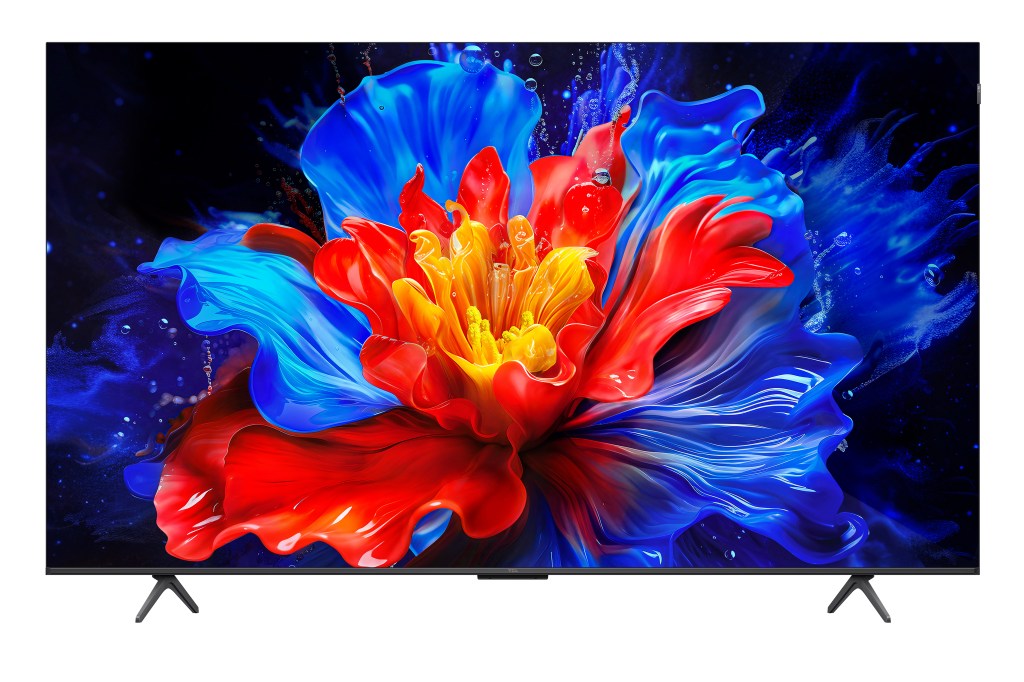
7. TCL P8K
Stuff Verdict
Great value for money and loaded with specs, the TCL P8K is a great TV if you’re on a budget.
Pros
- Excellent value for money with surprisingly strong specs
- Natural-looking picture quality with rich colours, especially in HDR content
Cons
- Lacks the brightness and contrast of pricier Mini-LED models, making dark scenes look a bit grey
- Cluttered remote layout with confusing button setup for accessing settings
| TCL P8K specs | |
|---|---|
| Screen | 3,840 x 2,160 pixels, 55/65/75in, QLED (Direct LED with Quantum Dot), 144Hz, ALLM, VRR, HDR10, HDR10+, Dolby Vision, HLG |
| Sound | 35W 2.1ch with Dolby Atmos |
| Connections | 4x HDMI (2x HDMI 2.1 incl. eARC, 2x HDMI 2.0), 1x USB-A, Ethernet, optical, Wi-Fi 5, Bluetooth |
| Operating system | Google TV |
| Dimension | 1224 x 770 x 292mm, 11.3kg (55in with stand) 48.2 x 30.3 x 11.5in, 24.9lb |
TCL is best known for big screen Mini-LED models at low prices. The TCL P8K is a 2025 model that replaces the C745K and sits in the middle of the line-up. It’s the most affordable model on our list and seeing as this is a new 2025 TV, there’s every chance it will get cheaper, so it’s a veritable bargain.
TCL has packed everything it can into the P8K, so you’re not left lacking. That means it offers surprising spec for the price, which I’ll get onto in a minute, but this is again a model that has feet towards the ends, so needs a wide stand to sit on.
The build of the TV is good with a raised Onyko subwoofer on the back while there’s also a small tag on the right side of the screen which says “Premium QLED” on it. Don’t worry, it doesn’t block visible pixels, but it’s a slightly intrusive design decision.
The TCL P8K runs Google TV and some of the remote’s functions reflect that, with a button directly into the Google TV settings. There’s a separate button that accesses the TV’s setting for things like picture control and sound control – and I wouldn’t blame you if you occasionally pressed the wrong button.
The TCL P8K uses a direct LED panel with Quantum Dots for colour and I found that it resulted in a very natural-looking picture, especially when viewing HDR content. It doesn’t have the brightness of the Mini-LED TVs on this list – or the Samsung Q80D – so the HDR doesn’t quite pop like it does on the brighter models.
But there’s plenty of richness to colours and plenty of controls to adjust things to your liking – accessed through that additional button on the remote I mentioned – and with some tweaking you’ll get some really impressive results.
I found this model preserving detail in some scenes that more expensive models lost, but in darker scenes it loses contrast, looking a little grey as the limitations of the display technology come through.
The sound doesn’t really leap out of the frame, it’s well enough balanced but nothing to get excited about, but the sheer volume of support for more advanced features is. This is a 144Hz panel so those connecting gaming devices are well served.
Best mid-range TV for UK streaming
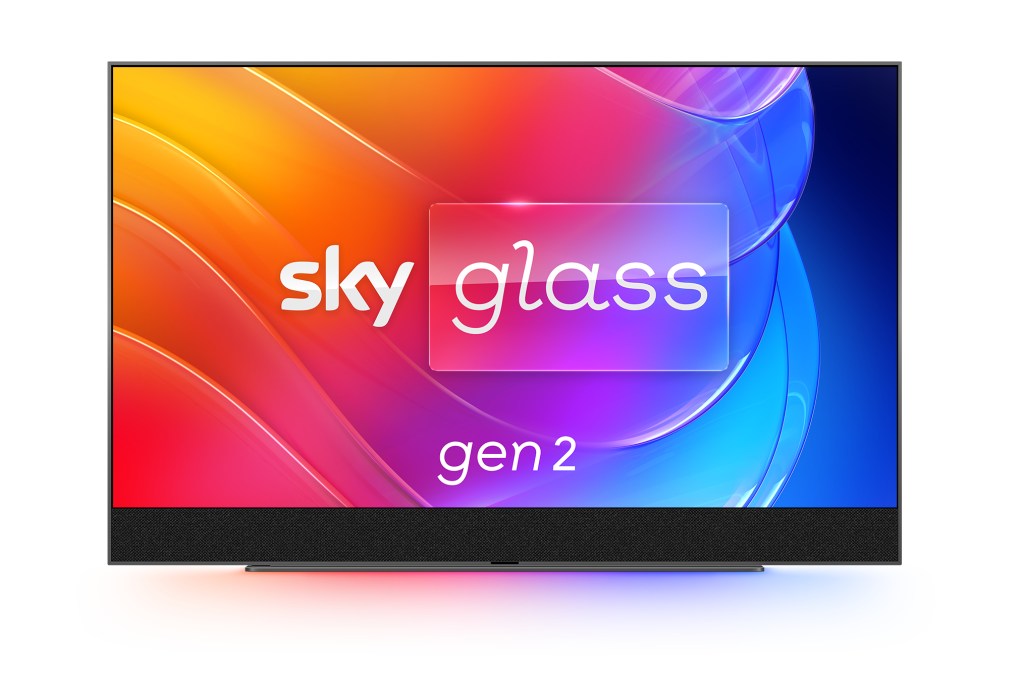
8. Sky Glass 2
Stuff Verdict
The integrated soundbar is a great feature, but Sky Glass 2’s appeal is really to those invested in Sky’s content.
Pros
- Built-in 250W soundbar delivers the best audio performance on this list
- Simple, all-in-one solution with integrated Sky Stream and no-fuss setup
Cons
- Limited picture controls and only a 60Hz panel, so not ideal for gamers or picture tweakers
- Picture quality doesn’t match rivals in darker scenes or for upscaling lower-res content
| Sky Glass 2 specs | |
|---|---|
| Screen | 3,840 x 2,160 pixels, 55/65/75/85in, QLED (Direct LED with Quantum Dot), 60Hz, ALLM, HDR10, Dolby Vision, HLG |
| Sound | 250W 3.1.2ch with Dolby Atmos |
| Connections | 3x HDMI 2.1 incl. eARC, 1x USB-A, 1x USB-C, Ethernet, Wi-Fi 6, Bluetooth |
| Operating system | Sky TV OS |
| Dimension | 1228.9 x 787.9 x 220mm, 21.9kg 48.4 x 31.0 x 8.7in, 48.3lb |
Sky Glass is an all-in-one solution from Sky for those looking for simplicity: you get a 4K HDR TV with a built-in soundbar, running on Sky OS for access to all that Sky content. It’s effectively a TV with Sky Stream built in.
Sky Glass 2 is brighter, with better local dimming and new picture modes to support different viewing scenarios to improve on the first version of this TV.
You can buy Sky Glass 2 outright or you can pay for it monthly and that makes buying Sky Glass 2 a little more complex, as you’ll be subscribing to Sky at the same time.
No tools are needed for the stand making setup really easy and there’s a substantial soundbar across the bottom of this TV, which explains the bulk. It’s easily the best sounding model on this list, but that’s perhaps reflected in the price and the hefty design.
With simplicity in mind, Sky Glass 2 doesn’t offer many picture control settings. Instead you have a range of viewing modes that the TV will automatically select. There are very few options for tinkering, so if you’re a picture tweaker, look elsewhere.
This is a direct-lit LED TV with quantum dots so similar to the tech you’ll find in the Samsung Q80D or the TCL P8K, although it’s only 60Hz, so not great for gaming. The contrast and colour isn’t as good as the Samsung model, it doesn’t handle dark scenes as well, and it lacks Samsung’s upscaling skills for lower quality content.
Connecting devices isn’t quite as intuitive as other TVs as there’s no input selector on the remote, instead you have to navigate to them in the UI, which is a little fiddly.
But let’s spare a minute to talk about the sound: there’s a 250W soundbar attached to the bottom of Sky Glass 2 with speakers in the top of the frame too, giving a much more immersive soundscape than any other TV on this list. If you’re after a no-fuss installation, then Sky Glass delivers that.
If you only watch Sky content and you’re looking for an all-in-one solution, then Sky Glass 2 is rather unique. It doesn’t match the others for picture quality in all scenarios, but it’s definitely easy to live with.
With prices from £19 a month (not available in the US) for the 55-inch version, it could be right up your street.
What to consider when buying a mid-range TV
Choosing the best mid-range TV isn’t just about picking the biggest screen you can afford. It’s about finding the right mix of size, features and performance that fits your space and how you actually watch. Here’s what to keep in mind.
How big is too big? Think about where the TV is going to go and how it will fit into your room, remembering that the size is the diagonal across the screen. Most people are buying 55 or 65-inch TVs, but wall-mounting larger sets is increasingly popular. Think about what you’re standing the TV on and if the TV’s feet will fit that stand. If you’re in a flat with a smaller living room, 50in might be more sensible – or a 55in with slim bezels and a centred stand. For a more cinematic setup, 65in and up starts to make sense.
How bright is your room? A sunlit room with loads of windows needs a brighter screen. This is where Mini-LED TVs shine (literally). They get brighter than regular LED sets and handle glare better, which is handy for daytime TV or sport. More nits means better HDR too – a win for film lovers.
What do you want your TV for? Gamers should look for HDMI 2.1 ports and 120Hz refresh rates (or more). That gets you smooth, low-lag performance, perfect for fast-paced titles. If movies are your thing and you have a darkened room for late-night Netflix binges, mid-range OLEDs are well worth it. You’ll get deep blacks and punchy contrast that LCDs can’t match.
What about the smart features? All TVs are “smart” now, but not all platforms are equal. If you’ve gone all-in on Alexa, a Fire TV interface makes voice control easy. Got a Google Nest setup? Google TV plays nice. Samsung’s Tizen system ties in with SmartThings if you use that ecosystem. And Freely support – which is becoming more common – means you can stream live TV without an aerial.
Finally, don’t overlook last year’s models. TV tech doesn’t change that fast, and you can often get a better-specced 2024 model for the price of a cut-down 2025 version.
How we test the best 4K TVs
We have tested and reviewed most of the 4K TVs on this list, so you can trust our recommendations when deciding which television to buy. Each TV undergoes a thorough review process that usually lasts at least a week, ensuring we have ample time to test every feature. We examine everything from software functionality to picture quality and audio performance, providing a comprehensive overview.
Our testing is designed to reflect how real users watch TV. We don’t just analyze technical specs – we immerse ourselves in a variety of content to see how the TV performs in everyday scenarios. For example, we watch a wide range of films, from visually stunning blockbusters like Furiosa: A Mad Max Saga to assess motion handling, to animated movies like Elemental to evaluate color accuracy and vibrancy. Dark, dramatic shows like The Perfect Couple allow us to test contrast, black levels, and shadow detail, ensuring the TV can handle a wide variety of genres. We also check how well the TV displays live sports, making sure motion remains smooth during fast-paced action.
We don’t stop at movies and TV shows and films – we also test gaming performance by hooking up one of the best gaming consoles and measuring input lag, refresh rates, and responsiveness to see how well the TV handles different gaming consoles and high-speed games.
Viewing angles are another critical factor we assess, ensuring the picture remains sharp whether you’re sitting directly in front or off to the side. Audio quality is evaluated both with built-in speakers and external sound systems.
By simulating real-world usage in different lighting conditions and with various media types, we ensure our reviews are very practical, helping you make the best choice when choosing your next 4K TV.
For more information on Stuff’s rating and review process, read our page on how we test products.
